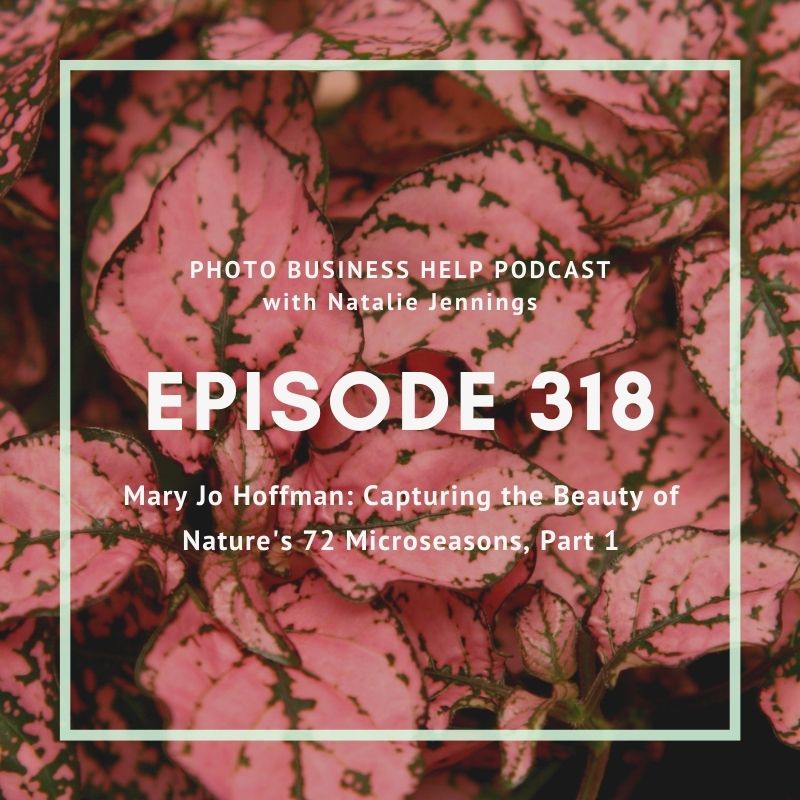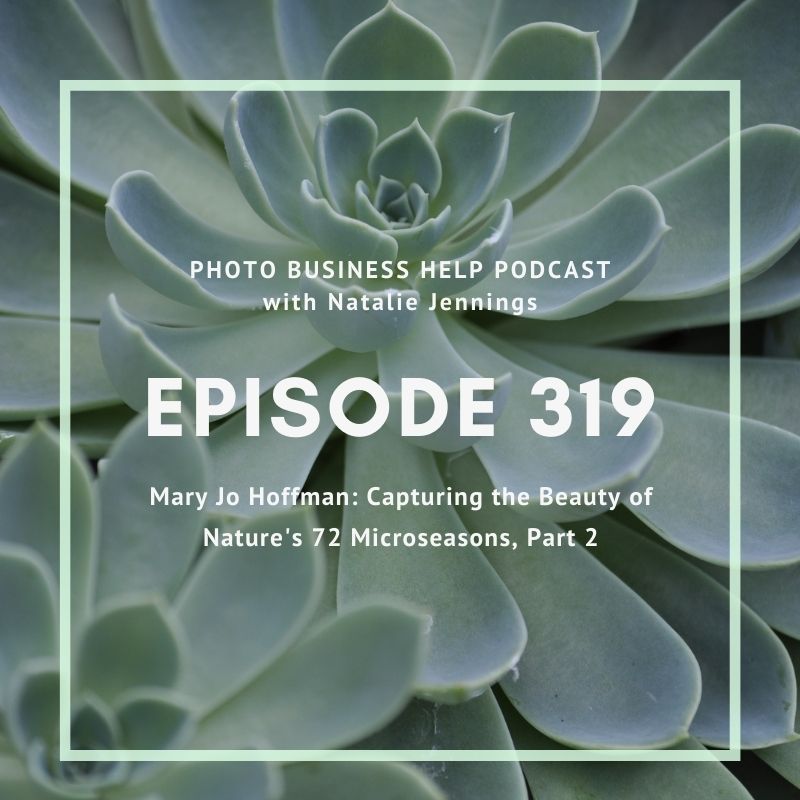Natalie: This week was such a joy for me. I am chatting with Mary Jo Hoffman. She is an absolutely incredible artist. But today, we're talking about a couple of really important to photography subjects. The first being the barrier to entry, which I've talked about before, but really exploring what you need to get started and what you don't need to have a successful photo career. That's one of my favorite topics. And then we're going to talk a lot about inspiration, finding your style, exploring consistency and commitment.
Well, hi, Mary Jo. Thank you so much for being here.
Mary Jo: Thank you. I'm honored and flattered.
Natalie: Likewise, I've been a huge fan of your work. We talked about this a little bit a few minutes ago, but finding you on Instagram and then just going down that rabbit hole of the gorgeous work that you do. Maybe we'll just kick it off by having you in your own words, describe the sort of work that you do.
Mary Jo: Sure. So I started 10 years ago a daily practice of photographing found nature every day that I would carry home when I was after I was walking my dog. And then I would put it on a white background, or a black, but most 90% of the time, a bright white background, and then, do a flat lay or portrait of the specimen or collection and photograph it and post it. So it's a super highly stylized photography. It's a very highly stylized form of nature photography.
It started as a personal project, a personal creative project, a daily project in my mind, it was a one-year project.
So I started it January 1st, 2012. It's 10 years. I don't know what I was thinking doing nature, found nature photography in my mind, it was a one-year project. January 1st. Three feet of snow in January 1st.
It was just like a crazy challenge to start found nature in Minnesota in January 1st. But I wasn't even thinking about that. I just was, it was a one-year project. I started January 1st and it was going to go to December. And I was posting it to a blog, which, when I started I had to Google, “what is a blog?”
I knew nothing. It was just a very personal project. Then six months into the project, it got a lot of press.
So by June, Martha Stewart living magazine had called and said, can we do a feature? And it was just crazy. They came and I said, sure. So they came in July, but they were going to feature me the following July.
In my mind, when the end of the year came, you know, I was going to be in Martha Stewart that next July, I felt like I had to keep going. And then that one thing led to another, once you're in Martha Stewart.
You know, all the local magazine said, who is this person? Why do we know about her? And so then they wanted to do features. And so one thing led to another, and here I am 10 years later doing a daily photographs of highly stylized daily photographs of found nature.
Natalie: That's so cool. Um, sort of commitment to projects. I've talked about it on the podcast, this being one of them. When I started this, I said, I'm going to do this for a year every Tuesday and Thursday. Listeners know that I also do tarot readings. I can completely relate to that because it really does keep you going. Yeah.

Mary Jo: Absolutely. And then you get momentum and I don't know when I started, I didn't know what a blog was. And so I was Googling “What is a blogger? What is WordPress?” I didn't know anything.
So I signed up for an online $30 blog class and the one thing they said was consistency, consistency, consistency, consistency. And so I got that message right away. Actually that was never my challenge. I committed to a one-year project, I was going to do it every day for a year, but I've done it every single day for 10 years now.
So I guess you could call consistency one of my superpowers, like I've never missed a day. I'll go on vacation and I'll preload. I used to actually bring my camera and keep doing it daily from wherever I was. But sometimes now I'm just traveling. You know, you're the whole day is in transit, so there's no time to take a photo. So I will preload for two or three days while I'm traveling.
Natalie: I'm glad you answered that question. I was like, “what do you do when you travel?”
Mary Jo: I'll preload for a day or two. What I like to do is take photos from wherever I am.
The whole idea is sort of being attentive to your surroundings and living in a heightened state of awareness.
If I'm going to be anywhere for any length of time, I'll bring my camera. I use a white background and at home, I'm very, very, very low tech. And at home I just use white poster board or a white diffuser or a transparent diffuser as my white background. But I can use a white sky.
I can use a white t-shirt. A lot of times I'll say to my husband, hold this agains your belly, cause he's got a white t-shirt. So I can use anything, an open page in my journal, whatever is white works.
Natalie: Well, I'm just, I'm taking a note to come back to that. Cause I don't want to forget a couple of the things you said, but I am really curious.
You said that consistency is your super power and for listeners of the show, I end almost every episode with “remember in everything you want to achieve, consistency is key.” So it's something I coach on a lot.
Because a lot of people, it's not their superpower, and it's something that's challenging for people. But what would you say is a challenge for you?
Mary Jo: That's a really good question. So it started as a daily creative project. So I have two kids when I started the project 10 years ago. They were little kids. So, 10 years in children's life is a long time. So I think, well, my son's 18, so he was eight when I started the project.
I had conceived and signed the project to fit around a busy family life, so it had to be easy. It had to be low tech. It had to be portable. I didn't want this daily challenge to disrupt family. We liked the family routines. I wanted it to fit within them. And so when I conceived the project, that was part of my constraints and then that ended up being super important because I couldn't do it for 10 years if it was difficult.
Natalie: That's a real thing. If you're going to try and undertake something for a year or more, and like it's totally not in your routine.
Mary Jo: Yeah, it's going to be a challenge and you're going to resent it and you're going to hate it. And yeah. So what happened is I designed it to be super easy and I picked nature. I wanted to do one of these daily projects. They were all the rage a while ago. People still do them, the one hundred day challenges. I'm a huge fan. I'm a huge fan for unlocking creativity because when you have that daily commitment, it just completely turns off the inner critic because you have to create something.
When you're doing it daily, not every day has to be great. It just has to be good enough. And then you get all those pleasant surprises when you do make something really great. And it happens more often than you'd think, you know, once you get rolling.
So I'm a huge fan of the daily practices, but back to your original question of what's my challenge. So the project is called still S T I L L like still life. And the blog where I post the images is called STILL blog. And when I started it quickly became a whole lifestyle. I didn't anticipate this at all, but it became this state of living in the heightened awareness because every day I had to find something new to photograph.
So it started with “I have to walk the dog every day.” I live in this nature setting. I have about five trails I walk daily, I'll pick one of them, they're all on the edges of lakes.
What I have access to is nature. And I happen to love nature. It turns out like I like it just suddenly my eyes were wide open. Every time I'm walking a dog, I'm looking, “what's changed?”
“What's new?” I've already done cat tails and milkweed. So I have to go beyond the obvious and start looking at the less obvious or the quiet or things that are going on on the trails. It just became this just really lovely lifestyle that I didn't want to stop. So, yes, I kept getting features and magazines that I felt like I owed it to the magazines to continue the practice, but I didn't want to stop.
It was a great way of living in the world to be that attentive all the time to my surroundings. I was learning a ton. So anyways, my biggest challenge hasn't been the consistency and hasn't been sort of the enthusiasm for the work. Cause I, you know, nature is it's never not interesting. I could do this for a thousand years and still not run out of stuff to notice.
My biggest challenge has been “how do I evolve the project?” I am working with a publisher and I'm having to do a book about these first 10 years of STILL. So I will be doing it for a little bit yet longer yet because of that. But at the same time, you know, it was a very stylized style. My style is very stylized. It's a flat layer, but it's kind of graphic. It's kind of modern.
Natalie: I know exactly what you mean.
Mary Jo: Yeah. So anyway, it's a very, it's a very stylish, but I've done this 10 years. I have this huge body of work. I'm really proud of it, but for the last several years, am I stuck? Am I repeating? And now I want to gather it all together in a book.
I'm really excited about the structure of the book was introduced recently to this concept of 72 microseasons that the Japanese and Chinese have, which I had been evolving to in my own just by being that attentive.
And so, the structuring of the book is going to be around the 72 microseasons.
My challenge right now, and it has been for several years is “What do I do next day? Do I evolve it? Do I evolve it in something similar but different?” Or do put a bow on it and then do something totally different.

Natalie: I can totally understand that challenge. And I think for myself, this is my 12th year full-time doing photography and I did 10 strong years of weddings. That was how I kicked everything off. I don't do them anymore, but just over the years, even with this podcast, actually this is over 300 episodes, like in my longer running product.
That is also a huge challenge for me. You get really good at something. You have a routine, you have like a way of doing it, and then it's like, “well, this is cool.” But I think that like creator in you is like “how do I evolve? Do I just leave it?”
So I'm curious, you had mentioned a little bit about like you're super low tech. Maybe just say a couple of things about what that looks like. Just so people can understand that it's okay to be low tech.
Mary Jo: I decided to be low tech. When I started in my mind to do it daily, it had to be uncomplicated. It had to be simple.
Natalie: Again, bringing that back in though is like, keep it simple.
Mary Jo: It's the only way that you can do a daily project. It has to be simple. And so I started with a Canon rebel, like three or something and no tripod. Nothing else. And then I did have an iMac and I did have Photoshop elements, which I continued to use for a really long time. And, you know, honestly, I, you know, obviously I have the full Adobe creative suite now.
I still only use Photoshop. I don't use Lightroom and it would be a whole lot easier if I did.
So I started with just a camera, even my soccer moms on the sidelines had better cameras than me to photograph their kids at soccer games, I had this like low end Canon.
After doing that for a while I evolved to a counter rebel five and then a seven, I think I'm currently, finally got a mark five.
Natalie: Are you using the same lens throughout?
Mary Jo: So yeah, so all that time, because it was always a cam I always did. I had a 28 or 30 or something lens 20, 35 lens or something. Then I gave that to my daughter. And I was also doing some photography for my husband for real estate. I needed more of a wide angle interior shots.
Natalie: See, I love this because this is helpful for people specifically, people starting out too, to just hear on a photography podcast that you can create absolutely beautiful work and you don't have to break the bank just to get into it.
Mary Jo: No, not at all. So my emphasis is always been on. I want to make art, I don't want to focus on the technical part, the equipment. I wanted to focus on composition for me. The daily practice was daily practice was really an exercise in composition. I wanted to get better at composition.
Ironically, I've gotten super knowledgeable about my natural environment. I've gotten, you know, pretty fast at Photoshop. I've gotten more skilled as a photographer, but I have still struggled with composition every day. So anyway, that the irony is that's the one thing I really wanted to do. And it's still the heart.
It's still the hardest part, composition. That artistic part was my fascination. Not that technical.
Natalie: Well, it shows, your art is so gorgeous. What would you say to anybody wanting to start either a once a day project. Is there anything that you just feel like sharing with artists or things that something that you've learned?
Mary Jo: yeah. I guess my thought was, I'm a huge fan of the daily project. If you're a wedding photographer, portrait photographer, carve a little time every day. It doesn't have to be a daily product. It can be once a week. Just these routine things where they come so fast that you can't, you can't be a perfectionist.
You can't worry that it's perfect every day or every week. And so I would say, give yourself a personal channel. You'll know fairly soon whether you're tapping into a personal style that feels authentic.
Do your weddings, do your portraiture and carve out a little thing where it's a personal practice. And give yourself a commitment to do it either daily or weekly for a certain period of time. The a hundred day challenges are super popular.
If you want it to stick or you want a personal style to evolve and just get started and see what comes out.
But, so I would say, you know, give yourself these personal projects. Keep them simple, keep it so simple or you won't do it. You'll hate it. You'll quit after three weeks.
Natalie: Thank you so much for chatting with me.
Mary Jo: My, my, it was super fun. I really enjoyed it. Thank you.
Instagram: https://www.instagram.com/maryjohoffman/

